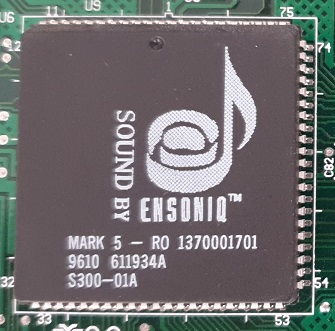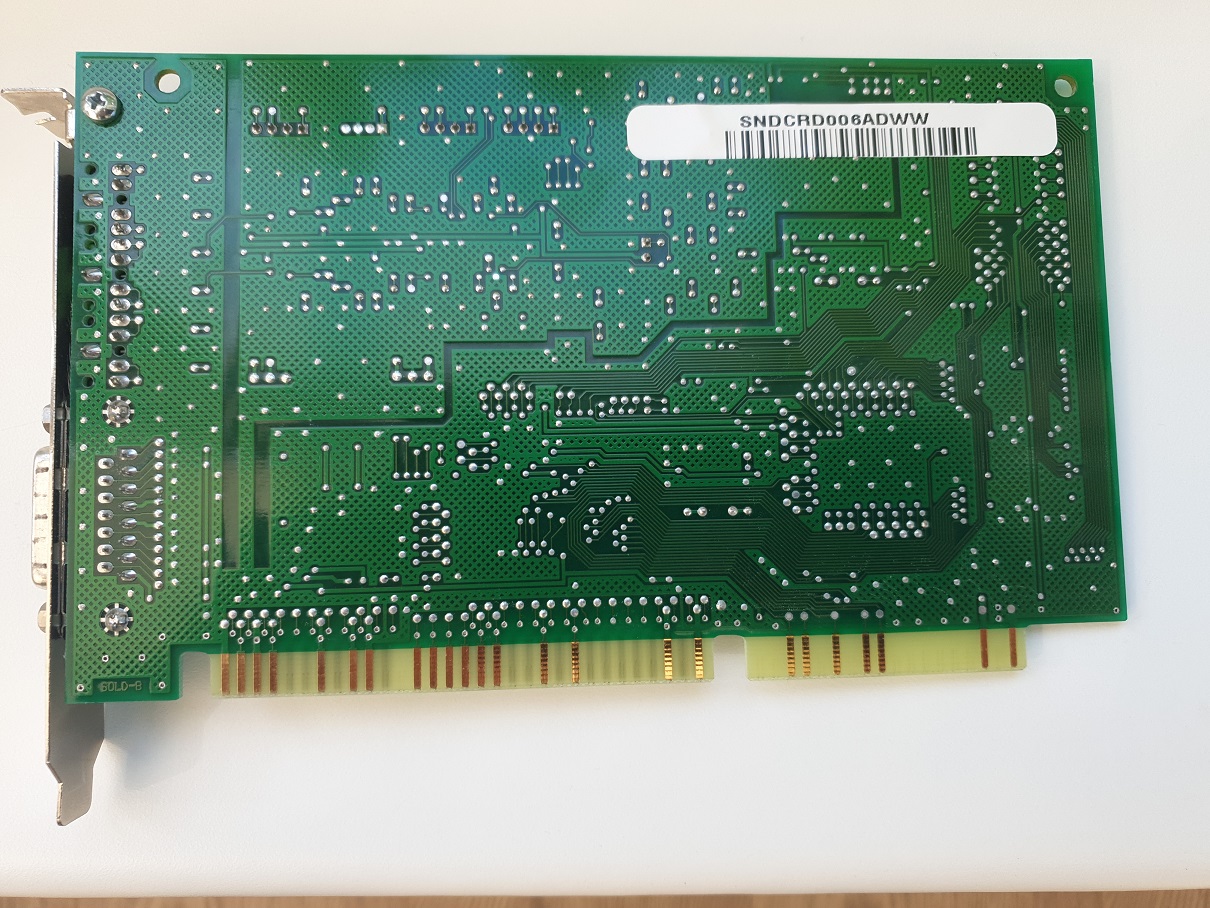Retro Review: Ensoniq SoundscapeVIVO
7th June 2022
In this week's retro review I am looking at another sound card I picked up recently - an Ensoniq Soundscape VIVO, also commonly called VIVO90 or VIVO-90.
Ensoniq Soundscape VIVO
Bought in June 2022 for £30
The VIVO can be considered part of the 2nd-generation of sound cards from Ensoniq, being launched in late 1995 - about a year after the original Soundscape which was also called S-2000. Rather than improving on its forebear, Ensoniq went into cost reduction mode for this generation. The earlier Soundscape was quite a premium product and they had even brought out an Elite version of it that included an effects processor daughterboard. So a year down the road, I'm sure Ensoniq were looking at the PC sound card market and at how many folks were snapping up the cheaper cards from the likes of Creative Labs or Aztech. Their response was to introduce 2 new cards: OPUS and VIVO. OPUS was sold only to Gateway 2000, while VIVO would also be sold through retail outlets.
In terms of cost-cutting, the most obvious changes were that OPUS and VIVO were much shorter cards, and CD-ROM interface headers were completely absent. This is fine though, since by 1995/1996 the proprietary optical interface war was over, with IDE to remain the de-facto standard (and these were now embedded on every motherboard).
So what can the VIVO do? Well... Ensoniq were careful enough to use a generic chip for FM compatibility by employing an Analog Devices AD1845JP CODEC - this provided Ad Lib, Sound Blaster Pro, and Windows Sound System functionality. But the main reason for having a VIVO was for the onboard wavetable, courtesy of the OTTO and MARK 5 chips. From Ensoniq's own website, it listed VIVO90's specifications like this:
|
|
The '1 megabyte (compressed)' is a good sign, as this tells us the samples stored were previously larger than the 1 MB, but they have been compressed to fit into a 1 MB ROM chip. Compression of course does compromise the purity/quality of the original samples, but with any luck these are the same decent samples they used on the original Soundscape 2 MB patchset, just compressed. Other lesser cards might have advertised 1 MB compressed to mean you have 512 KB of actual stored samples.
The other point to note is the 90 dB signal-to-noise ratio - a decent figure for what was sold as a lower budget sound card.
SoundscapeVIVO Revisions
Looking around for a VIVO card today can be slightly confusing, but really there are just 3 flavours, and they are fundamentally the same.
| Card Identification | Revision info |
|---|---|
| VIVO-A | Has OTTOR2, OTTOR2B, OTTOR2C or OTTORED chip dated from late 1995 to late 1996. Has MARK5-RO chip only (no MARK5-ROA variant) Two DM74LS373WM logic chips in bottom-left corner. Solder pads for Matsushita CD audio-in Only one jumper on the board (JMP1), used to provide 2.5V of phantom power to the mic/line-in jack. Audio ports are coloured black, green and black. |
| VIVO90DB-A | Has OTTOR2C or OTTORED chip dated from mid-1996 to mid-1997. Most have MARK5-ROA chip (a few early ones use MARK5-RO variant) One DM74LS373WM logic chip in bottom-left corner. No Matsushita CD audio-in option Two jumpers on the board at JMP1 - (1) for phantom power to the mic/line-in jack and (2) a mono/stereo setting. Audio ports are coloured black, green and red. |
| VIVO90UG-A | Has OTTOR2C or OTTORED chip dated from mid-1996. Has MARK5-ROA chip only One DM74LS373WM logic chip in bottom-left corner. No Matsushita CD audio-in option Two jumpers on the board at JMP1 - (1) for phantom power to the mic/line-in jack and (2) a mono/stereo setting. Audio ports are coloured black, green and red (same as 90DB-A). |
 The ES5506 OTTO chip gives the VIVO card its wavetable synthesis. First seen on Ensoniq's first card, Soundscape S-2000, it has 32 separate voice channels that can be configured independently of each other. It's designed to work alongside the MARK 5 chip and the Motorola 68000 CPU which means the Soundscape VIVO does all its own processing on the card, freeing up your computer's CPU for other things. The vast majority of sound cards do not do this - one exception is some higher-end Turtle Beach cards. It is a little surprising Ensoniq put a 68000 on these lower budget sound cards - I assume OTTO's design necessitated this, so they had no choice but to provide it or redesign the OTTO chip to use the PC's host CPU.
The ES5506 OTTO chip gives the VIVO card its wavetable synthesis. First seen on Ensoniq's first card, Soundscape S-2000, it has 32 separate voice channels that can be configured independently of each other. It's designed to work alongside the MARK 5 chip and the Motorola 68000 CPU which means the Soundscape VIVO does all its own processing on the card, freeing up your computer's CPU for other things. The vast majority of sound cards do not do this - one exception is some higher-end Turtle Beach cards. It is a little surprising Ensoniq put a 68000 on these lower budget sound cards - I assume OTTO's design necessitated this, so they had no choice but to provide it or redesign the OTTO chip to use the PC's host CPU.
So good was the OTTO chip that Advanced Gravis used it for their UltraSound and UltraSound Max, which was then rebranded by numerous other sound card manufacturers. Note that on the VIVO cards I have seen, only R2, R2B, R2C and RED revisions are present. There must have been a R1 [Release 1] at some point, maybe used on Ensoniq's keyboards perhaps?
OTTO R2 was also used on Ensoniq's wavetable daughterboard, SoundscapeDB, coupled with a Motorola 68000 CPU and a 2 MB sample ROM chip.
 The 84-pin Mark 5 chip is a bit of an unknown - there is very little mention of it on the internet, so I'm guessing here. The fact that the OTTO has no DAC or ADC built-in (and there isn't an obvious one on the VIVO board), and that the Mark 5 is not present on the wavetable daughterboard, tells me that it's for processing the audio created by OTTO, i.e. it's a DAC and ADC chip, though that's a lot of chip for just those tasks - there has to be more to it than that - if you know, please get in touch!
The 84-pin Mark 5 chip is a bit of an unknown - there is very little mention of it on the internet, so I'm guessing here. The fact that the OTTO has no DAC or ADC built-in (and there isn't an obvious one on the VIVO board), and that the Mark 5 is not present on the wavetable daughterboard, tells me that it's for processing the audio created by OTTO, i.e. it's a DAC and ADC chip, though that's a lot of chip for just those tasks - there has to be more to it than that - if you know, please get in touch!
Look out for the upcoming Part 2, where I install the drivers and get it up and running.

